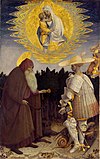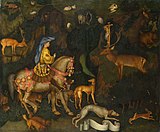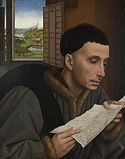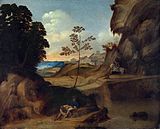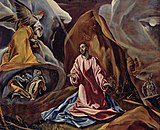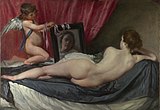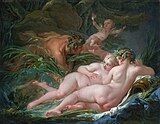National Gallery, London
(Redirected from National Gallery)
National Gallery , London, ![]() United Kingdom
United Kingdom
| National Gallery
|
|||
|---|---|---|---|
| Native name | National Gallery | ||
| Parent institution | Board of Trustees of the National Gallery | ||
| Location | |||
| Coordinates | | ||
| Established | 1824 | ||
| Website | nationalgallery.org.uk | ||
| Authority file | |||
art museum in London, England, UK | |||||
| Upload media | |||||
| Instance of | |||||
|---|---|---|---|---|---|
| Part of |
| ||||
| Location | Trafalgar Square, City of Westminster, Greater London, London, England | ||||
| Street address |
| ||||
| Located on street | |||||
| Architectural style | |||||
| Architect | |||||
| Has part(s) |
| ||||
| Founded by | |||||
| Heritage designation |
| ||||
| Inception |
| ||||
| Date of official opening |
| ||||
| Visitors per year |
| ||||
| official website | |||||
 | |||||
| |||||
The National Gallery in London, founded in 1824, houses a rich collection of over 2,300 Western European paintings. It occupies the north side of Trafalgar Square.
Building
[edit]-
National Gallery, filmed in 1890 by Wordsworth Donisthorpe
-
Aerial view
-
Close-up of the entrance portico
-
The Sainsbury Wing
Interior
[edit]-
Staircase Hall (1887, by Sir John Taylor)
-
Staircase Hall
-
Central Hall
-
The Barry Rooms
-
The Barry Octagon
-
The Barry Octagon
-
Sainsbury Wing
Plans
[edit]-
1836 plan of the National Gallery and Royal Academy, signed by the architect William Wilkins
-
Plan of the ground floor (c 1894)
-
Plan of the first floor (2006)
Collections
[edit]Main category: Paintings in the National Gallery, London
1250–1399
[edit]-
Cimabué, The Virgin and Child with Two Angels, circa 1265–1280
-
Duccio di Buoninsegna, The Healing of the Man Born Blind, 1307/8–1311
-
Duccio di Buoninsegna,The Transfiguration, 1307/8–1311
-
Duccio di Buoninsegna, The Virgin and Child with Saints Dominic and Aurea, circa 1312–1315
-
Ugolino di Nerio, Santa Croce Altarpiece, 1325–1328
1400–1499
[edit]-
Jan van Eyck, Léal Souvenir, 1434
-
Jan van Eyck, Arnolfini Portrait, 1434
-
Robert Campin, Portrait of a Man, circa 1435
-
Robert Campin, Portrait of a Woman, circa 1435
-
Pisanello, The Virgin and Child with Saints, circa 1435–1441
-
Rogier van der Weyden, The Magdalen Reading, before 1438
-
Paolo Uccello, Niccolò Mauruzi da Tolentino at the Battle of San Romano, circa 1438–1340
Gordon 1981 -
Follower of Robert Campin, The Virgin and Child Before a Firescreen, circa 1440
-
Stefan Lochner, Three Saints, circa 1450
-
Workshop of Rogier van der Weyden, A Man Reading (Saint Ivo?), circa 1450
-
Dieric Bouts, The Entombment, probably 1450s
-
Giovanni di Paolo, Saint John the Baptist Going into the Wilderness, 1454
-
Andrea Mantegna, The Agony in the Garden, c. 1458–60
-
Giovanni Bellini, The Agony in the Garden, c. 1465
-
Bartolomé Bermejo, Saint Michael and the Devil, c. 1468
-
Dieric Bouts, Christ Crowned with Thorns, c. 1470
-
Paolo Uccello, Saint George and the Dragon, c. 1470
-
Piero della Francesca, The Nativity, 1470–5
-
Workshop of Andrea del Verrocchio, Tobias and the Angel, circa 1470–1475
-
attr. Piero del Pollaiolo, Apollo and Daphne, c. 1470–80
-
Antonio Pollaiuolo, The Martyrdom of Saint Sebastian, 1475
-
Antonello da Messina, Portrait of a Man, c. 1475–6
-
Hans Memling, The Donne Triptych, c. 1478
-
Hieronymus Bosch, The Crowning with Thorns, between 1479 and 1516
-
Sandro Botticelli, Portrait of a young Man , c. 1483
-
Sandro Botticelli, Venus and Mars , c. 1485
-
Carlo Crivelli, The Annunciation, 1486
-
Domenico Ghirlandaio, ca. 1480-1490
-
Lorenzo Costa, A Concert, 1488-1490
-
Geertgen tot Sint Jans, The Nativity at Night, c. 1490
-
Portrait of Battista Fiera, 1490-1495, National Gallery
-
Andrea Mantegna, The Virgin and Child with Saints, probably 1490–1505
-
Piero di Cosimo, A Satyr Mourning over a Nymph, c. 1495
-
Pietro Perugino, Pavia Polyptych, late 1490s
-
Albrecht Dürer, Saint Jerome, c. 1496
-
Albrecht Dürer, Portrait of the Artist's Father at 70, 1497
-
Michelangelo, The Virgin and Child with Saint John and Angels (The Manchester Madonna), 1497
1500–1599
[edit]-
Sandro Botticelli, Mystic Nativity , c. 1500–01
-
Cima da Conegliano, Saint Jerome in a Landscape, c. 1500–10
-
Giovanni Bellini, Doge Leonardo Loredan, after 1501
-
Leonardo da Vinci, The Virgin of the Rocks, c. 1503–6
-
Giorgione, The Sunset, c. 1505
-
Giovanni Bellini, Madonna del Prato, 1505
-
Raphael, The Madonna of the Pinks, c. 1506–7
-
Leonardo da Vinci, The Virgin and Child with St. Anne and St. John the Baptist, c. 1506–8
-
Jan Gossaert, Portrait of a Girl, c. 1500–30
-
Jan Gossaert, Adoration of the Magi, c. 1510–5
-
Michelangelo, The Entombment, c. 1510
-
Titian, The Holy Family with a Shepherd, circa 1510
-
Titian, Portrait of a Man with a Quilted Sleeve, c. 1510
-
Titian, La Schiavona, c. 1510
-
Gerard David, The Virgin and Child with Saints and a Donor, probably 1510
-
Raphael, The Aldobrandini Madonna, 1510
-
Sebastiano del Piombo, The Daughter of Herodias, 1510
-
Titian, Noli Me Tangere, c. 1512
-
Raphael, Pope Julius II, c. 1512
-
Hans Baldung, Portrait of a Man, 1514
-
Sebastiano del Piombo, The Madonna and Child with Saints, circa 1517
-
Jacopo Pontormo, Joseph in Egypt, 1517-18
-
Andrea del Sarto, Portrait of a Man, c. 1517–18
-
Sebastiano del Piombo, The Raising of Lazarus, 1517–19
-
Albrecht Altdorfer, Christ taking Leave of his Mother, c. 1520
-
Palma il Vecchio, A Blonde Woman, c. 1520
-
Joachim Patinir, St. Jerome in a Rocky Landscape, c. 1520
-
Titian, Bacchus and Ariadne , 1520–3
-
Correggio, Venus with Mercury and Cupid ("The School of Love"), c. 1525
-
Lucas Cranach the Elder, Cupid complaining to Venus, c. 1525
-
Quinten Massys, A Grotesque Old Woman, c. 1525–30
-
Hans Holbein the Younger, Lady with a Squirrel and a Starling (Anne Lovell?), 1526–8
-
Parmigianino, The Mystical Marriage of Saint Catherine , c. 1527–31
-
Titian, The Aldobrandini Madonna, circa 1532
-
Hans Holbein the Younger, The Ambassadors, 1533
-
Lorenzo Lotto, Portrait of a Lady as Lucretia, 1533
-
Giovanni Gerolamo Savoldo, Mary Magdalene, 1535–40
-
Hans Holbein the Younger, Christina of Denmark, Duchess of Milan, 1538
-
Titian, The Vendramin Family, c. 1543–7
-
Agnolo Bronzino, Venus, Cupid, Folly and Time, 1545
-
Paolo Veronese, The Conversion of Mary Magdalene, c. 1548
-
Giovanni Battista Moroni, Portrait of a Gentleman, c. 1550
-
Titian and workshop, An Allegory of Prudence, circa 1550–65
-
Portrait of Piero de' Medici, 1550 bis 1570
-
Jacopo Tintoretto, Saint George and the Dragon, c. 1555
-
Titian, Diana and Actaeon, 1556–9
-
Titian, Diana and Callisto, 1556–9
-
Titian, The Tribute Money, circa 1560–8
-
Titian, The Death of Actaeon, 1562
-
Paolo Veronese, Infidelity, c. 1565
-
Paolo Veronese, The Family of Darius before Alexander, 1565–70
-
Titian, The Virgin Suckling the Christ Child, circa 1565–75
-
Joachim Beuckelaer, The Four Elements: Water, 1569
-
Giovanni Battista Moroni, The Tailor, c. 1570–5
-
Jacopo Tintoretto, The Origin of the Milky Way, c. 1575
-
El Greco, Adoration of the Name of Jesus, 1577–80
-
El Greco, The Agony in the Garden, 1590s
-
Caravaggio, Boy Bitten By a Lizard, 1593–4
1600–1699
[edit]-
Caravaggio, The Supper at Emmaus , 1601
-
Annibale Carracci, Christ appearing to St Peter on the Appian Way, 1601–2
-
Caravaggio, Salome with the Head of John the Baptist, 1607–10
-
Hendrick Avercamp, A Winter Scene with Skaters near a Castle, 1608–10
-
Peter Paul Rubens, Samson and Delilah, c. 1609–10
-
Artemisia Gentileschi, Self-Portrait as Saint Catherine of Alexandria, c. 1616
-
Guercino, The Dead Christ Mourned by Two Angels, c. 1617–8
-
Hendrick ter Brugghen, A Man playing a Lute, 1624
-
Frans Hals, Young Man Holding a Skull (Vanitas) 1626–8
-
Nicolas Poussin, The Adoration of the Golden Calf, 1633–6
-
Philippe de Champaigne, Cardinal de Richelieu, 1633–40
-
Rembrandt, Saskia van Uylenburgh in Arcadian Costume, 1635
-
Francisco de Zurbarán, Saint Francis in Meditation, 1635–9
-
Peter Paul Rubens, The Judgement of Paris, c. 1636
-
Rembrandt, Belshazzar's Feast, c. 1636–8
-
Anthony van Dyck, Lady Thimbelby and Viscountess Andover, c. 1637
-
Anthony van Dyck, Equestrian Portrait of Charles I, c. 1637–8
-
Francisco de Zurbarán, Saint Francis in Meditation, 1639
-
Rembrandt, Self-Portrait at the Age of 34, 1640
-
Salvator Rosa, Self-portrait, 1640
-
Claude Lorrain, Seaport with the Embarkation of Saint Ursula, 1641
-
Philippe de Champaigne, Triple Portrait of Cardinal de Richelieu probably 1642
-
Rembrandt, The Woman taken in Adultery, 1644
-
Diego Velázquez, The Rokeby Venus, 1647–51
-
Claude Lorrain, Seaport with the Embarkation of the Queen of Sheba, 1648
-
Claude Lorrain, Landscape with the Marriage of Isaac and Rebecca, 1648
-
Nicolas Poussin, Landscape with a Man Killed by a Snake, 1648
-
Diego Velázquez, Philip IV of Spain in Brown and Silver, c. 1652–5
-
Carel Fabritius, Young Man in a Fur Cap, 1654
-
Rembrandt, A Woman bathing in a Stream (Hendrickje Stoffels?), 1654
-
Rembrandt, Portrait of Hendrickje Stoffels, c. 1654–6
-
Pieter de Hooch, The Courtyard of a House in Delft, 1658
-
Rembrandt, Self Portrait at the Age of 63, 1669
-
Bartolomé Esteban Murillo, Self-Portrait, probably 1670–3
-
Jan Vermeer, A Young Woman seated at a Virginal, c. 1670–2
-
Jan Vermeer, A Young Woman standing at a Virginal, c. 1670–2
-
Claude Lorrain, Landscape with Aeneas at Delos, 1672
-
Bartolomé Esteban Murillo, The Heavenly and Earthly Trinities ("The Pedroso Murillo"), c. 1675–82
-
Meindert Hobbema, The Avenue at Middelharnis, 1689
1700–1799
[edit]-
Antoine Watteau, The Love Song, c. 1717
-
Canaletto, The Stonemason's Yard, c. 1725
-
Jean-Baptiste Siméon Chardin, The Young Schoolmistress. c. 1735–6
-
Canaletto, A Regatta on the Grand Canal, c. 1740
-
William Hogarth, The Shrimp Girl, c. 1740–5
-
William Hogarth, Marriage à-la-mode: 1. The Marriage Settlement, c. 1743
-
William Hogarth, Marriage à-la-mode: 2. The Tête à Tête, c. 1743
-
William Hogarth, Marriage à-la-mode: 3. The Inspection, c. 1743
-
William Hogarth, Marriage à-la-mode: 4. The Toilette, c. 1743
-
William Hogarth, Marriage à-la-mode: 5. The Bagnio, c. 1743
-
William Hogarth, Marriage à-la-mode: 6. The Lady's Death, c. 1743
-
Pompeo Batoni, Time orders Old Age to destroy Beauty, c. 1746
-
Thomas Gainsborough, Mr and Mrs Andrews, c. 1750
-
Jean-Étienne Liotard, The Lavergne Family Breakfast, 1754
-
Louis Tocqué, Portrait of Mademoiselle de Coislin, c. 1750–9
-
Pietro Longhi, Exhibition of a Rhinoceros at Venice, 1751
-
Jean-Honoré Fragonard, Psyche showing her Sisters her Gifts from Cupid, 1753
-
Giovanni Battista Tiepolo, An Allegory with Venus and Time, c. 1754–8
-
Giovanni Antonio Canal, Two Views of Piazza San Marco: Venice, Piazza San Marco and the Colonnade of the Procuratie Nuove, 1756
-
François Boucher, Pan and Syrinx, 1759
-
George Stubbs, Whistlejacket, c. 1762
-
François-Hubert Drouais, Madame de Pompadour at her Tambour Frame, 1763–1764
-
Joseph Wright of Derby, An Experiment on a Bird in the Air Pump, 1768
-
Johann Zoffany, Portrait of Mrs Oswald, c. 1770
-
Joshua Reynolds, Lady Cockburn and her Three Eldest Sons, 1773
-
Thomas Jones, Wall in Naples, 1782
-
Joshua Reynolds, Portrait of Colonel Banastre Tarleton, 1782
-
Elisabeth Vigée-Lebrun, Self Portrait in a Straw Hat, after 1782
-
Thomas Gainsborough, Mrs Siddons, 1785
-
Thomas Gainsborough, The Morning Walk, 1785
-
George Stubbs, A Gentleman Driving a Lady in a Phaeton, 1787
-
Thomas Lawrence, Portrait of Queen Charlotte, 1789–90
-
Jacques-Louis David, Portrait of Jacobus Blauw, 1795
1800–1912
[edit]-
Francisco Goya, Doña Isabel Cobos de Porcel, 1806
-
Caspar David Friedrich, Winter Landscape, c. 1811
-
Francisco Goya, The Duke of Wellington, 1812–4
-
Théodore Géricault, A Horse Frightened by Lightning, c. 1813–14
-
John Constable, The Hay Wain, 1821
-
John Constable, The Cornfield, 1826
-
Eugène Delacroix, Portrait of Louis-Auguste Schwiter, 1826–30
-
Julius Schnorr von Carolsfeld, Ruth in Boaz's Field, 1828
-
J. M. W. Turner, Ulysses Deriding Polyphemus, 1829
-
Paul Delaroche, The Execution of Lady Jane Grey, 1833
-
J. M. W. Turner, The Fighting Temeraire, 1838
-
J. M. W. Turner, Rain, Steam and Speed: The Great Western Railway, 1844
-
Jean-François Millet, The Winnower, c. 1847–8
-
Jean Auguste Dominique Ingres, Madame Moitessier, 1856
-
Edgar Degas, Young Spartans Exercising, c. 1860
-
Édouard Manet, Music in the Tuileries, 1862
-
Pierre-Cécile Puvis de Chavannes, The Beheading of John the Baptist, c. 1869
-
Claude Monet, Bathers at La Grenouillère, 1869
-
Claude Monet, The Beach at Trouville, 1870
-
. 1874. oil on canvas. 73 × 59.7 cm (28.7 × 23.5 in)
-
Edgar Degas, Miss La La at the Cirque Fernando, 1879
-
Berthe Morisot, A Summer's Day, 1879
-
Pierre-Auguste Renoir, The Umbrellas, 1881–5
-
Georges Seurat, Bathers at Asnières, 1883–4
-
Vincent van Gogh, Sunflowers, 1888
-
Vincent van Gogh, Van Gogh's Chair, 1888
-
Vincent van Gogh, A Wheatfield, with Cypresses, 1889
-
Gustave Moreau, Saint George and the Dragon, 1889–90
-
Henri Rousseau, Surprised!, 1891
-
Edgar Degas, After the Bath, Woman drying herself, c. 1896–8
-
Paul Cézanne, Bathers, 1894–1905
-
Claude Monet, The Water-Lily Pond, 1899
-
John Singer Sargent, Lord Redesdale, 1902
-
Gustav Klimt, Portrait of Hermine Gallia, 1904
-
Akseli Gallen-Kallela, Lake Keitele, 1905
-
Odilon Redon, Ophelia among the Flowers, 1905–8
-
Joaquín Sorolla, The Drunkard, Zarauz, 1910
-
George Bellows, Men of the Docks, 1912
-
L. A. Ring, Road in the Village of Baldersbrønde (Winter Day), 1912
Bibliography
[edit]- Gordon, Dillian (1981) The National Gallery, London: 100 Great Paintings – Duccio to Picasso, London: National Gallery

































